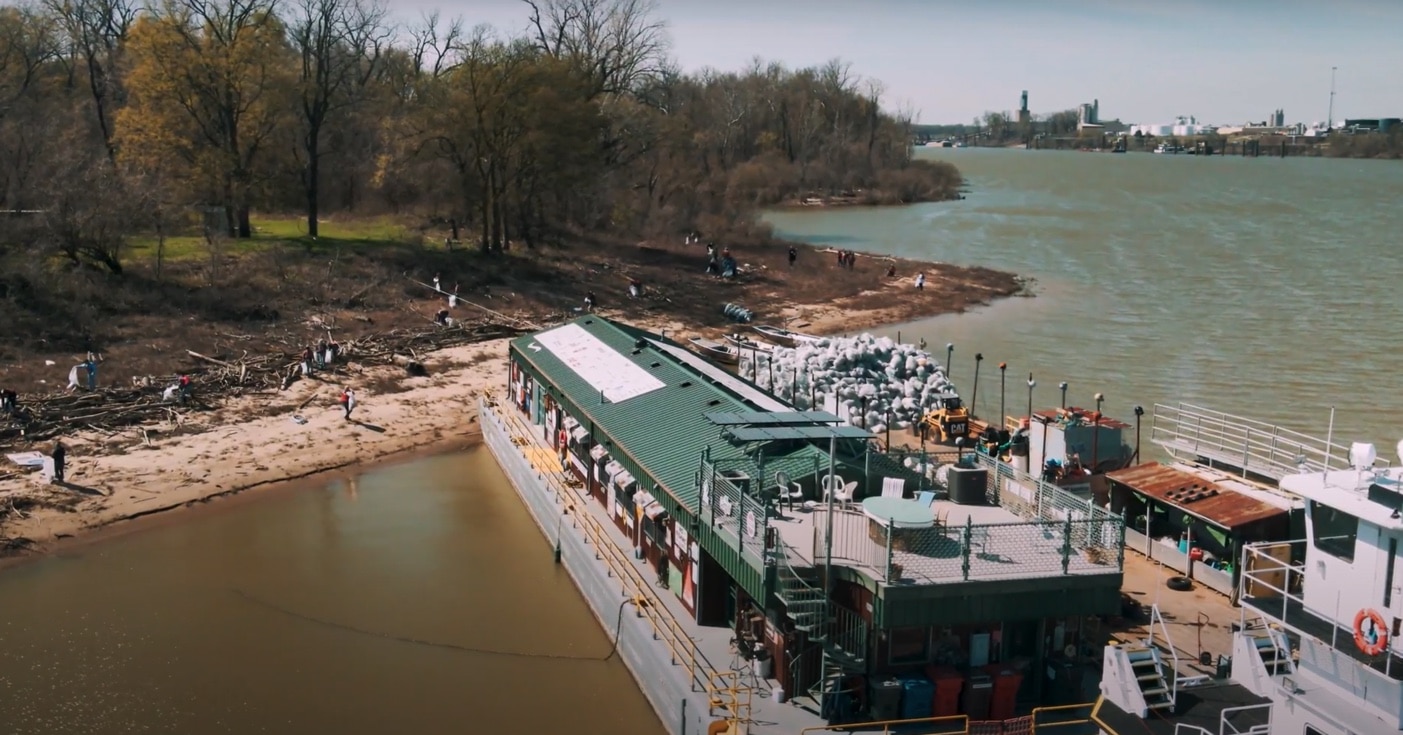RIVERS ARE LIFE
Cash “The Conservation Kid” Daniels of Chattanooga, Tennessee, has always had a strong love of animals–especially sea life. He was seven years old when he learned that 80% of the trash in the ocean comes from rivers. Instead of leaving him demoralized, the fact inspired him to take action in his local waterway, the Tennessee River.
The Tennessee River
The Tennessee River begins in Knoxville, Tennessee and flows into the Ohio River at Paducah, Kentucky. It’s over 650 miles long and one of the most biodiverse river systems in North America. Its upper basin hosts over 200 native freshwater fish, mussels, and birds. But it’s also home to 18,000 microplastics per cubic meter of water (as of 2018) that threaten the health of the river and its inhabitants.
When Cash leads river cleanups at the Chattanooga creek, his crew of kids and adults remove everything from everyday plastic to old tires no one wanted to pay to recycle. But one of the biggest threats to the river and its wildlife is far more subtle than chunks of broken-down rubber.
The Dangers of Fishing Waste

Discarding a used lure or line might seem like a harmless act at the moment, but littered fishing waste is a serious threat to aquatic wildlife all over the world. When not properly disposed of, lines and lures can cause entanglement, choking, and poisoning of the local species as the current takes it down to the ocean.
Fishing lines are especially designed to be as strong in relation to their thickness as possible, so while they may not look particularly threatening, their thin diameter can cut into and damage an animal’s tissue if they become entangled. The line is also resistant to biting by trapped animals, so unless a human comes along to save them, it’s unlikely the victim will ever make it out. Fishing line isn’t biodegradable, either. If no one picks it up, it will stay in the environment for decades to come.
The Damage to Local Wildlife
Plastic fishing lines and lures aren’t just unsightly. Plastic deposits can severely harm the health of the river and the native animal populations. These biologically diverse ecosystems are already under multiple threats, including climate change and habitat degradation. Swallowed lures can prevent freshwater turtles from being able to eat, leaving them to slowly starve to death.
Freshwater species are especially at risk of exposure to fishing waste, as they’re in closer proximity to human activity–but the danger to wildlife doesn’t end in the local river.
From the Rivers to the Oceans
The fishing line that doesn’t entrap or choke the native species will make its way down to the ocean, where it can kill animals as large as dolphins. Fishing gear traps 83% of entangled bird species globally, and 36% of seabirds have been caught in plastic or other synthetic materials.
Sixty to seventy percent of all plastic sinks, and once it’s out of sight, it’s largely out of mind. Plastic materials will eventually break down into microplastics, which are too small to easily be detected, but still pose a major threat to the ecosystem.
Microplastic Pollution
The Tennessee River is one of the most microplastic-polluted rivers in the world. Microplastics are easily and frequently absorbed by fish and mussels, which then make their way up the food chain to the human population. In addition to entering the food supply, microplastic accumulation can cause liver issues in fish and block the digestive tracts of zooplankton.
Research regarding the effects of microplastics on freshwater environments and their inhabitants is ongoing, but it’s clear they don’t interact positively with any ecosystem they enter.
Microplastics don’t just get in the systems of a few different species–they can also leach plasticizer pollutants that produce toxicological effects on organisms. This is especially concentrated in plastics created from polymers–which make up most modern fishing lines.
The Conservation Kid at Work
Cash Daniel’s award-winning work in river preservation addresses the problem of pollution from multiple angles. In addition to leading hands-on trash cleanups and talking to other kids about conservation, he’s written a book about his conservation work and implements preventive measures to keep plastic fishing waste out of the water in the first place.
Taking Waste to Make Something New
Cash collects aluminum cans to fund the key part of his conservation strategy–filament bins. Cash builds the bins by hand and places them where the fishers of the Tennessee River frequent. The bins give the fishers a convenient and responsible disposal method for their used fishing lines and lures. The waste gathers at the bottom of the bin, where Cash collects it and sends it off to be recycled into new habitats for fish.
Getting Other Kids Involved

Cash also works to motivate his generation to help clean up their local ecosystem. He founded the organization “The Cleanup Kids” with his friend Ella, and visits schools to talk to other kids about the importance of river conservation and how they can get involved. By teaching them peer to peer, he inspires them to follow in his footsteps now instead of waiting until they’re older to take action.
A Bright Future For Chattanooga
The Tennessee River Gorge Trust invited Cash out to their bird observatory to show him the impact he’s had on the river. The members of the trust use birds as “indicator species” to help inform them about the overall health of the river. Because of Cash’s tireless work, they’ve seen an increase in the local bird populations (specifically the worm-eating warbler, the Louisiana waterthrush, and the belted kingfisher.)
Knowing there is a younger generation to carry on the legacy of conservation gives the members of the trust hope. Cash Daniels is leading a community of students who care about the environment and are ready to do what it takes to protect it.
“Even though kids may be a small part of the population, we are 100% of the future,” Cash says.
Share this
You May Also Like
These Related Stories

Max & Fran: Glass Half Full

Why Rivers Matter

